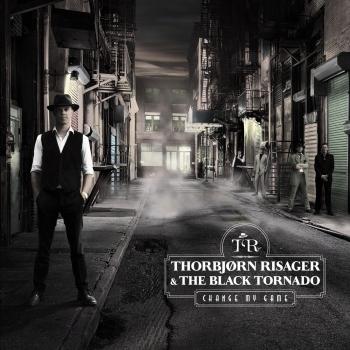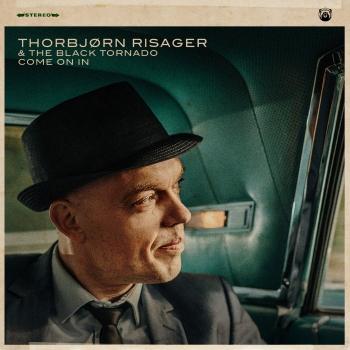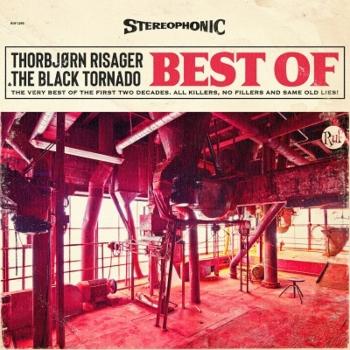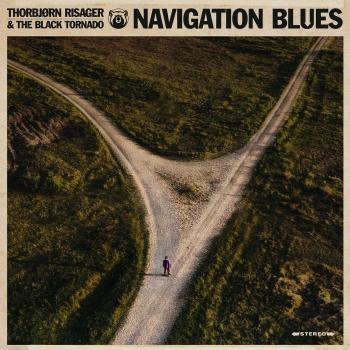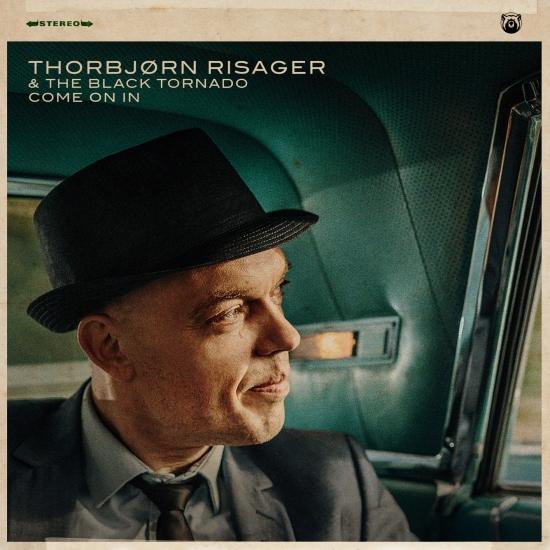
Come On In Thorbjørn Risager & The Black Tornado
Album info
Album-Release:
2020
HRA-Release:
31.01.2020
Album including Album cover Booklet (PDF)
- 1Come On In04:11
- 2Last Train03:25
- 3Nobody But The Moon04:18
- 4Two Lovers05:13
- 5Never Givin' In04:53
- 6Sin City04:03
- 7Over The Hill03:41
- 8On And On05:18
- 9Love So Fine03:50
- 10I'll Be Gone03:10
Info for Come On In
The popular and award-winning orchestra brings forth a new album: 'Come On In'. The intensity is intact, but there is also room for new streaks of melancholy.
Through more than 1,000 concerts in 21 different countries, the hard swinging and critically acclaimed ensemble has made people smile and dance. For that is what the blues is capable of: grooving away life’s problems. The front man knows this better than most, and on the 10th album - with the inviting title 'Come On In' - he goes into clinch with everything from his own age to political reality.
In this way, the title symbolizes everything that Thorbjørn Risager & The Black Tornado stand for.
Thorbjørn explains: “Some people think the blues is sad because it’s named after the color of the melancholy and has its roots in music played by the slaves in the United States. But you have to remember that this was music that people gathered around when they were trying to relax from their hardships. It emerged in festive situations and was meant to be danced to. I would like to help lift that tradition: To try to ease your problems through music, and then go home with a smile on your lips."
In 2019, these musicians still work in the same way as when they began. Thorbjørn Risager sits at home with his acoustic guitar and creates the core of the song before they enter the studio, where everyone offers beats, bass lines, horn parts, backup vocals and fills. All that provides the Black Tornado with a sound that evokes a feeling of the elements raging around Risager's voice.
Their open-minded and innovative approach to the blues adds elements to the songs from genres like funk, gospel, soul and rock 'n' roll. It all depends on the feeling and the direction of the song. One of the significant nuances of the new album is its axis of melancholic songs with acoustic guitar. It has instinctively arisen because the blues now reflects where Risager stands in life.
“The blues is my outlet. And this time, I've written some songs about having doubts about whether I'm the right place in my life. However, there is something fundamental in my songwriting that seeks the light. Which is about clenching your teeth together, saying, 'I'll just keep moving on'.”
'Never Giving In' is exactly such a tune, while 'Last Train' addresses the concern of falling too deep into yourself. 'Nobody but the Moon' shows a rare political side of Thorbjørn Risager when it asks the questions: Who saw the children who drowned in the Mediterranean, and who heard their screams? And it answers: "Nobody but the moon."
In the midst of all the seriousness, however, the album's title song 'Come On In' highlights the uplifting community that Thorbjørn Risager & The Black Tornado want to create. It revolves around a bar where everyone is welcome, and Risager has written it with Mojo Blues Club in Copenhagen in mind. Because as he says, "That's where we in the band grew up and many of us met our girlfriends."
Some orchestras break through and fade out. Others give up if the breakthrough doesn't immediately show up. And then there are those for whom it is a matter of life and death to play music, steadily gaining popularity by keeping the standards high year after year. Thorbjørn Risager & The Black Tornado belong to the latter category. Quietly, both in Denmark and abroad, there is a growing awareness of their explosive concerts, in which guitar, bass, drums, organ and horns surround Risager's powerful vocals – reviewers have drawn parallels to both Ray Charles and Joe Cocker.
The Blues has been in his bloodstream ever since he, at the age of 10, heard something absolutely magical. In his home in Jyllinge, his two music teacher parents primarily put classical records on the turntable, but at the neighbour’s house another world opened up. Thorbjørn was too young to understand the depth of the roots, the amount of dust and gravel, the size of the pain, and not least the redeeming euphoria of singing it all out. He just knew that he had to take it home with him. So he got cassette tapes with the exotic music and for years he was falling asleep to the sounds of Fats Domino and Muddy Waters.
Thorbjørn Risager, vocals, guitar
Emil Balsgaard, piano, organ, wurlitzer, synthesizer
Joachim Svensmark, guitar, synthesizer, bg vocal
Kasper Wagner, alto saxophone, tenor saxophone, baritone saxophone
Hans Nybo, tenor saxophone
Peter Kehl, trumpet, flugelhorn, trombone, sousaphone
Søren Bøjgaard, bass, moog bass, synthesizer
Martin Seidelin, drums, percussion

 Thorbjørn Risager
Thorbjørn Risager
In the blues world, a big voice is often accompanied by a big ego (or at least a medium sized one…)
But the Danish singer Thorbjørn Risager, praised for his rough and strong voice by an unanimous choir of critics from a growing number of countries – 15 the last time we counted them – is a soft-spoken gentleman off stage. He is the leader of his seven-piece band mainly for practical reasons – to bring any little issue into a group discussion can be quite time-consuming. He is also composing most of the band’s music, and during the performance he is the obvious center of attention, even if the band has a charming way of passing round the task of introducing the songs between them, so that each musician gets his word in.
And this is a real smooth organization, who has divided all practical tasks such as web master, CD sales on gigs etc between themselves. Which makes life easier in the midst of their heavy touring schedule. Since the start, they have played in 15 countries, and only from Feb – Aug 2010 they have concerts booked in 11 European countries.
But the 38-year-old Dane had other plans for his life. He studied to be a school teacher, and worked in this profession for some years, before he decided to let the music take over. He studied at the Rhythmic Conservatory in Copenhagen, a quite unique education where many of the teachers are jazz- or rock musicians, and where the emphasis is on Rhythmic music of all genres.
In 2003 he started his band, selected musicians he liked both musically and personally, and the fact that up until today only one of them left and was replaced, at an early stage of the band’s career, proves that the choice was excellent.
But of course Thorbjørn’s musical interest started long before this. He played the saxophone from the age of 12, then guitar – but the singing was more of a coincidence at first. He was exposed to the blues through a neighbour, a middle-aged gentleman who was friends with his parents, and who started playing blues records to the young Thorbjørn. That’s how his life-long love story with the blues started, with B B King as his biggest hero. Ray Charles is one of his other obvious influences, but today, with almost 40 recorded songs from his own pen, he has definitely defined his own sound and style.
His mixture of genres is something that is sometimes mentioned by critics, who are looking for something of more homogenity. But this is Thorbjørn’s deliberate choice. To hear a band that plays one shuffle after another, or only jump blues through an entire CD or concert, might please some critics but there’s definitely a risk that the audience will get bored.
And this is why Thorbjørn and his band have created their specific sound by other means, especially his characteristic raunchy voice and the band’s typical sound, with its horns, solo performances and rolling, almost big-band-like grooves. So he weaves threads of soul, gospel, rock, R&B and funk into his music, to create a variety and keep the audience interested, something that the band succeeds with on each single gig.







